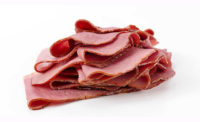Phosphate is unique in that it is the only ingredient other than salt that has been traditionally used and interacts directly to modify meat proteins and protein functionality.
For example, alkaline phosphates increase the pH of muscle, which increases protein extraction, emulsion stability and water-holding capacity, which reduces cooking loss, explains Lynn Knipe, extension processed meat specialist and associate professor in Food Science and Technology and Animal Sciences at Ohio State University in Columbus. As a result of increasing water-holding capacity, phosphates cause increased juiciness and perceived tenderness. Phosphates also serve as antioxidants and a water softener by binding iron, calcium, magnesium, etc., which initiate oxidation and cause water hardness, he says.
Because phosphate offers multiple functions, it is a very popular ingredient. “Phosphates are commonly added to increase the binding properties also to hold more water in the product,” says Jacob Nelson, meat-processing specialist for the Robert M. Kerr Food and Agricultural Products Center at Oklahoma State University in Stillwater. “Phosphate does a great job in holding water in processed meat products. In addition, phosphate can act as an antioxidant by chelating metals or in other words phosphate can ‘tie-up’ with metals to reduce lipid oxidation. Any oxidative changes can lead to lower product acceptance mainly from a tasting or sensory perspective.”
From a chemistry side, phosphate also can increase pH of the meat, moving the isoelectric point away from the normal, hence, greater water-binding capacity.
With the growth of clean-label, natural and organic meat and poultry products, a growing trend to limit phosphates has developed, says Ranjith Ramanathan, associate professor in the Department of Animal and Food Sciences at Oklahoma State University.
“Although there are some health concerns, none of the claims has been validated,” he says. “It can be a challenge to validate because on average no one will eat processed meat three times a day times 365 days.”
Knipe agrees that phosphates are not being used in new and existing meat products that are targeted for natural and/or clean-label products, which is a growing market.
“Most processors are working on how to best replace phosphates in their products,” he says. “However, there are still a lot of traditional cooked products being made which contain traditional phosphates.”
The reason why phosphate is widely used is because of its unique properties, but the most common replacement ingredient is sodium bicarbonate. “However, if you compare the efficacy, bicarbonate is lower than phosphate,” Nelson says. “There is also some trend to add proteins and plant-based polysaccharides … in meat to increase binding properties.”
With the unique properties of phosphates, it has been very difficult to find a good replacement for phosphates in meat products. “Whereas there are many ingredients such as soy, wheat proteins, starches, milk proteins, collagen proteins, etc., which have an indirect effect on water-holding capacity and may function to replace a portion of what phosphates do, a combination of these ingredients may be needed to properly replace phosphates,” Knipe says. “There are other ingredients such as citrates and carbonates that also interact directly with the meat proteins, and may be the closest to phosphates in terms of direct functionality effects on meat proteins, but the quality benefits of these ingredients have been variable. The challenge still exists to find ingredients that replace the functional properties of inorganic phosphates, but which is an ingredient that can be used in a clean or natural ingredient listing.”
With the focus more on consumers’ demands for clean labeling, Ramanathan says the use of phosphate will be challenging moving forward. “It will be hard to replace phosphate, but a combination of multiple ingredients can be an option,” he says. NP







